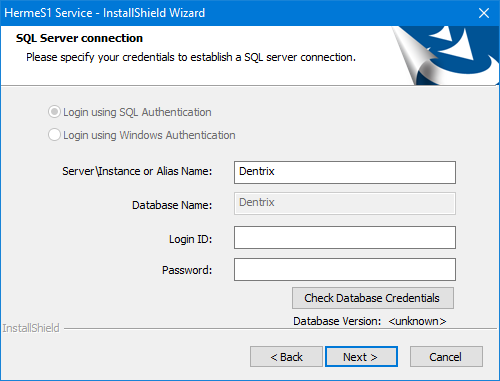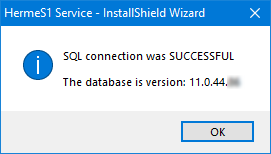Install/upgrade the server features of Dentrix Enterprise on your database server.
Note: If program files for a previous version of Dentrix Enterprise exist on the database server, if you do not need to access Dentrix Enterprise on the server, you can uninstall the Dentrix Enterprise client features.
Important: After installing/upgrading Dentrix Enterprise, to get the most recent set of available SNOMED, RxNorm, LOINC, and CVX codes, contact a technical support representative, so that person can run a utility to update the database.
To install the Dentrix Enterprise server features
To start the installation, double-click the setup file (EnterpriseServer-11.0.44.xxx.exe; where "xxx" represents the revision number).
The Welcome to the Dentrix Enterprise Server Install version 11.0.44.xxx screen appears.

Click Next.
The Database Agreement screen appears.

Read the agreement.
Select the I accept the database agreement terms option.
Notes:
You must accept the terms to continue.
To print or save a copy of the agreement, click Print.
Click Next.
A message appears, reminding you to back up your database before proceeding.

After you have verified that you have a current backup, click OK.
The SQL Server connection screen appears.
Select one of the following options:
Login using SQL Authentication - To connect to the database using the credentials of an SQL user with "Sysadmin" rights (such as Enterprise or SA).

Login using Windows Authentication - To connect to the database using the credentials of the current Windows user (if the user has "Sysadmin" rights to the SQL database).

Set up the following options as applicable:
Server\Instance or Alias Name - The name or IP address of the database server. Also, if the SQL instance that houses your Dentrix Enterprise database has a name, after the IP address or name of the server, include a backslash (\) and then the instance name.
Login ID - (Available only for SQL authentication) The user name of the SQL user with "Sysadmin" rights.
Password - (Available only for SQL authentication) The password of the Sysadmin user.
Click Check Database Credentials.
If a message appears, stating that the connection was successful, click OK.

Click Next.
If a message appears, informing you that the Enterprise user's password must be changed the next time someone logs in to Dentrix Enterprise as the Enterprise user, click OK.

The Choose Install Options screen appears.

Set up the following options:
Run SQL Update Scripts - To update the database, select this checkbox. To not update the database, clear this checkbox.
Note: This checkbox is available only if the Active Directory Authentication checkbox is clear.
Active Directory Authentication - If users are authenticated automatically through Active Directory when they open Dentrix Enterprise, select this checkbox. If users enter a user name and password to access Dentrix Enterprise (SQL authentication), clear this checkbox.
Call Installer for Selected Windows Services - Either select this checkbox to install all services, or click the plus sign (+) to view the available services and select the services that you use.

The following services are available:
Report Scheduling Service - Installs or updates the report scheduling service, which handles report jobs that have been scheduled from this or other computers.
Notes:
This service can also be installed on a different computer as part of a client installation.
This service only needs to be installed on one computer.
Dentrix Data Service (eligibilities) - Installs or updates the automation service for eligibility verifications and ERA retrievals.
Dentrix Recurring Payments Service - Installs or updates the recurring payments service (for credit cards processed through Axia).
File Exchange Service - Installs or updates the file exchange services.
Dental Encounter Service - Installs or updates the dental encounter service (for military facilities only).
Document Unfiled Utility Service - Installs or updates the document unfiled utility service (for military facilities only).
Note: A client installation is also required for this feature.
HermeS1 - This service (which is used for the automated collection of system information by Support technicians) is required.
Click Next.
If the Dentrix Recurring Payments Service checkbox was selected, a message regarding multiple instances of this service being installed appears. Click OK.

If the Document Unfiled Utility Service checkbox was selected, a confirmation message regarding a client installation being required appears. Click Yes.

Note: Clicking No returns you to the Choose Install Options screen.
The Ready to Install the Program screen appears.

Review the specified installation options, and then click Install.
If the Run SQL Update Scripts checkbox was selected, a command prompt window appears and displays the progress of the scripts to update the database.

Upon completion, on the message about the scripts that appears, click OK.

The log file opens in Notepad.

Check the log for any errors. If the log indicates that the database was updated successfully, close the document. If there are any errors, contact Dentrix Enterprise Customer Support at 800-372-4346 to resolve the errors before continuing with the installation.
On the message about re-running the scripts that appears, click Cancel to continue.

Note: Clicking Retry returns you to the SQL Server connection screen (see step 7).
The Welcome to the InstallShield Wizard for HermeS1 Service screen appears.

Do the following to install the HermeS1 service:
Click Next.
The Choose Destination Location screen appears.

Note: The default location where the program files are installed is C:\Program Files (x86)\DXONE\HermeS1.
To change the installation location, do the following:
Click Change.
Do one of the following:
Select a folder in the directory tree.
Enter the path to a folder.
Click OK.
Click Next.
The SQL Server connection screen appears.

Enter the following connection details:
Server\Instance or Alias Name - The name or IP address of the database server. Also, if the SQL instance that houses your Dentrix Enterprise database has a name, after the IP address or name of the server, include a backslash (\) and then the instance name.
Database Name - Dentrix is the default name of the database, but it may be different if it has been customized for your installation.
Login ID - The user name of an SQL user with "Sysadmin" rights (such as Enterprise or SA).
Password - The password of the Sysadmin user.
Click Check Database Credentials.
If a message appears, stating that the connection was successful, click OK.

Click Next.
The Start Copying Files screen appears.

Click Install.
When the process is finished, the InstallShield Wizard Completed screen appears.

Click Finish.
Follow the instructions for installing/upgrading each applicable service in turn:
Dental encounter.
Document unfiled utility.
The InstallShield Wizard Completed screen appears.

Click Finish.